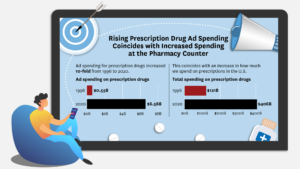Abstract
Context
Scholars have suggested that direct-to-consumer advertising (DTCA) of prescription drugs may discourage or encourage changes in lifestyle to improve health. The current paper informs this debate by examining associations between estimated exposure to DTCA for drugs focused on heart disease/cholesterol and diabetes and self-reported exercise and consumption of a variety of unhealthy foods (candy, sugary drinks, alcohol, and fast food).
Methods
We estimated exposure to DTCA by combining data from Kantar Media Intelligence (Kantar) on televised pharmaceutical DTCA airings in the U.S. from January 2003 to August 2016 (n = 7,696,851 airings) with thirteen years of data from the Simmons National Consumer Survey (Simmons), a mailed survey on television viewing patterns. We estimated associations between exposure to advertising (both overall and for advertisements with specific content) and self-reported physical activity and dietary behavior using Simmons data from January 2004 to December 2016 (n = 288,483 respondents from n = 157,621 unique households in the U.S.). Our analysis controls for many potential confounders including respondent demographics, temporal trends, and program placement to account for purposeful ad targeting to higher-risk adults.
Findings
Higher estimated exposure to DTCA for heart disease and diabetes drugs were not consistently associated with meaningful differences in the frequency of engaging in regular physical activity. Greater estimated exposure to DTCA for both diseases were, linked to small but consistently higher volume of consumption of candy, sugar-sweetened beverages, alcohol, and fast food. Specific DTCA message content about diet and exercise explained very little of the observed association between overall DTCA exposure volume and study outcomes.
Conclusions
Many Americans were regularly exposed to pharmaceutical DTCA for heart disease and diabetes from 2003 to 2016. Widespread exposure to such DTCA is associated with higher levels (though small in magnitude) of consuming alcohol, fast food, candy, and sugar-sweetened beverages.
The full study can be viewed at Social Science & Medicine.
Niederdeppe, J., Avery, R. J., Liu, J., Mann, C., Sood, N., & Eisenberg, M. D. (2023). Is exposure to pharmaceutical direct-to-consumer advertising for heart disease and diabetes associated with physical activity and dietary behavior?. Social Science & Medicine, 116062.
Sign up for Schaeffer Center news

